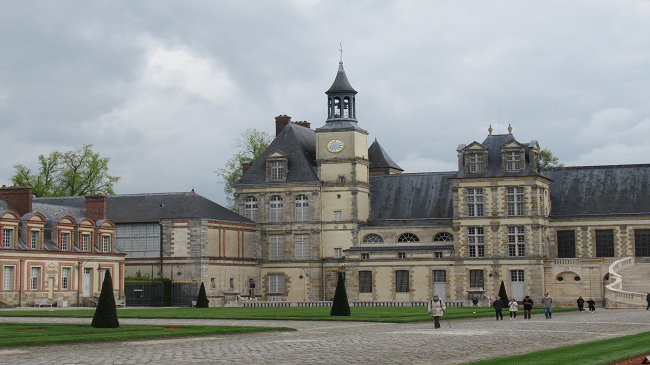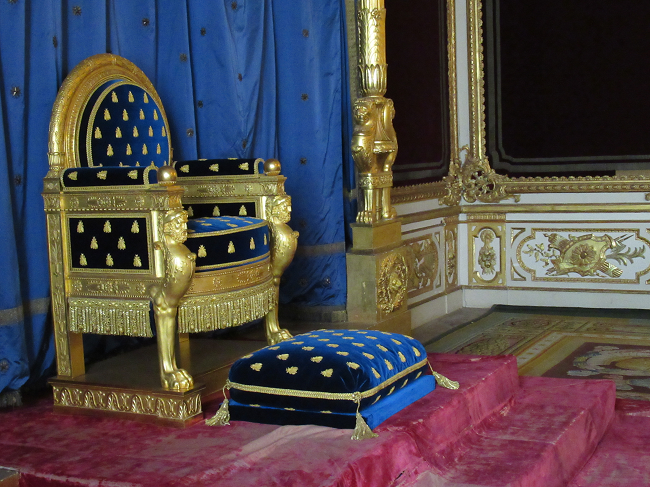Journey Through Royal History at the Château de Fontainebleau


- SUBSCRIBE
- ALREADY SUBSCRIBED?
BECOME A BONJOUR PARIS MEMBER
Gain full access to our collection of over 5,000 articles and bring the City of Light into your life. Just 60 USD per year.
Find out why you should become a member here.
Sign in
Fill in your credentials below.
Less visited than Versailles, Château de Fontainebleau is one of our favorite day trips from Paris.
A medieval turret here, a renaissance façade there, Napoleon’s initial on the entrance gates … as soon as you arrive at Fontainebleau it’s clear that it’s a patchwork of architectural splendor. And no wonder, for this stunning château was inhabited by all the kings of France from the 12th to the 19th century. They came primarily to hunt in the surrounding forests, but many of them were also determined to make their mark on the architecture, the interior design or the landscaping.
Knowing a little about those who did most to shape the Château de Fontainebleau turns visiting it into a journey through French history. Medieval kings gave way to the renaissance, then came the splendors before the revolution and the emperors and restored monarchs who followed it. Here then, are the top 10 kings, queens and emperors who most influenced the Fontainebleau you can visit today, together with the dates of their reign.

The gates at Château de Fontainebleau. © Marian Jones
1. Medieval Prestige
Louis VII (1137-1180)
The earliest château on this site pre-dated Louis VII, but it was he who first established its importance by issuing a Royal Charter, written in Latin, from his “Palace of Fontainebleau” during the first year of his reign. In the 1160s he further enhanced its prestige by building a chapel dedicated to the Virgin Mary and Saint Saturnin which was consecrated by no less a person than Thomas Becket. The Saint Saturnin Chapel you see today was built later, but Louis had secured Fontainebleau’s reputation as an important seat for French kings.

Saint Louis Portrait. Moralized Bible created in Paris, France, between 1227-1234. The Morgan Library and Museum. Public domain.
2. A mix of styles
Louis IX (1226-1270)
Louis IX, the only French king to be sainted, often used his “dear Fontainebleau” as a retreat for prayer and in 1254, on returning from a crusade to the Holy Land, he founded the Couvent des Trinitaires next to the château, overseeing the building of a monastery, a church and a hospital. The name lives on in the Trinity Chapel, built in a later reign. Under François I these religious buildings were merged with the castle, thus beginning the tradition of mixing architectural styles which led to the higgeldy-piggeldy charm of today’s Fontainebleau.

The famous staircase at the Chateau de Fontainebleau. Wikimedia commons
3. The Cradle of the French Renaissance
François I (1515-47)
It is thanks to the ambitious redesigns of François I that Fontainebleau is still known today as the birthplace of the French Renaissance. Of all the building works he oversaw, the most stunning is the Gallery of Francis, a long room built in 1528 to connect the king’s apartments with the monastery next door. Its lower half is decorated with intricate walnut panelling, lavishly embellished with gilded carvings of the letter F – his initial – and of the fleur-de-lis which represented the monarchy and the salamander which was his own personal emblem.
Italian artists were brought in to create the frescos which hang above the paneling, lavish mythological scenes representing the virtues of the king, framed by elaborate stucco work. Among this group, now known as the First School of Fontainebleau, was the sculptor and goldsmith Benvenuto Cellini. François I spared no expense on this room, and he was so proud of his creation that he is said to have kept the key to the gallery around his neck, granting entrance only to a favored few.

The Galerie François Ier at the Chateau de Fontainebleau. Photo credit: Neil Rickards / Wikimedia Commons
4. The Renaissance Flourishes
Henri II (1547-59)
Henri II, son of François I, continued the extension of Fontainebleau equally extravagantly, best illustrated by the renaissance style ballroom. Henri also made sure his initial featured prominently and gilded H’s are the centerpiece of the intricate ceiling panels, alongside his personal symbol – a crescent moon – and the intertwining letters H and D to include his mistress, Diane de Poitiers. Further examples of renaissance style are the room’s imposing fireplace, decorated with bronze copies of classical Roman statues, the musicians’ gallery and the frescos whose mythical themes cover the walls.

The ballroom ceiling at the Chateau de Fontainebleau. © Marian Jones
5. A Time of Splendor
Henri IV (1589-1610)
Henri IV’s influence is very noticeable in the grounds. He extended the buildings around the Oval Courtyard and harmonized the façades, creating an elegant whole. He created private gardens for himself and a large parterre or formal garden through which he had built a 1200-meter grand canal, 60 years before Louis XIV did the same at Versailles. He added the carp pond, where his guests could enjoy boating parties and fishing, and also the Jeu de Paume court, still the largest anywhere in the world. His reign at Fontainebleau is often referred to as un temps de splendeur.

Anne of Austria’s bedchamber at the Chateau de Fontainebleau. © Marian Jones
6. Grand Designs
Louis XIII and Anne of Austria (1610-43)
Both Louis and Anne – the parents of Louis XIV – left significant marks on Fontainebleau. Louis oversaw a major reconstruction of the iconic horseshoe-shaped stairway at the far end of the main courtyard, a favorite stop on any tour. After his death, his wife, Anne of Austria, now acting as regent for their four-year-old son, had the Queen Mother’s Wing so sumptuously decorated that it was later used by Napoleon as guest accommodation for Pope Pius. He visited in 1804 for the emperor’s coronation. The ornate ceiling, built in 1644, bears Anne’s initials.

Grand Parterre du Château de Fontainebleau. Photo credit: Jvillafruela/ Wikimedia commons
7. Transforming the Grounds
Louis XIV (1643-1715)
The Sun King spent longer at Fontainebleau than any other monarch, and he made major changes to the gardens. He replaced some of the smaller gardens with a grander, classical layout, designed by André Le Notre, who later designed the garden at Versailles. Louis enhanced the carp pond too, commissioning the architect Louis Le Vau to design a pavilion for a small island in its center. Louis XIV left fewer changes here than some of his predecessors, but it was at Fontainebleau that he began rehearsing the grandiose ideas which would be further embellished at the Palace of Versailles.

Marie Antoinette’s turkish boudoir at the Chateau de Fontainebleau.
8. Pre-revolutionary Excess
Marie Antoinette (1774 – 1792)
Louis XVI made some additions at Fontainebleau, but today you are more likely to notice traces of his wife, Queen Marie-Antoinette. Much of the decoration of the Queen’s Bedchamber and the next-door Queen’s Boudoir, designed specifically as a private retreat for Marie-Antoinette, are reminders of the queen whose reign ended in the French Revolution. The finest materials – mother of pearl, gilded bronze, satin and ebony – were used, but the ornate bed designed for her was completed only after her last visit to Fontainebleau. Marie-Antoinette’s desk and table are some of the few original items remaining; much of the rest was looted or auctioned after the revolution.

Napoleon’s throne at the Chateau de Fontainebleau. © Marian Jones
9. A Throne and an Abdication
Napoleon (1804 – 1814/15)
Napoleon, predictably, made a huge impact on Fontainebleau. In 1808 he transformed the King’s Bedroom into a Throne Room, complete with a throne from the Tuileries Palace and decorations based around his initial and his symbol, the imperial eagle. He had a whole suite of rooms redesigned, adding golden imperial emblems to the walls of his bedroom and commissioning a bed decorated with sculptures representing Glory, Justice and Abundance. He transformed the Gallery of Diana, installed by Henri IV, into a gallery extolling the achievements of his empire.
You can visit his library and his map room, reminders that even when “relaxing” at Fontainebleau he was ruling an empire. But this was also the scene of his demise. It was on the horseshoe staircase overlooking the main courtyard that he stood to bid his soldiers farewell in April 1814, before his exile to Elbe. His speech began “Soldiers of my Old Guard: I bid you farewell” and ended “Adieu, my friends. Would I could press you all to my heart.” You can also visit the Salle d’Abdication, where he signed the document which ended his reign. And in the Museum of Napoleon you can see all manner of mementoes: portraits, medals, souvenirs from his military campaigns and even a gold leaf from the crown he wore during his coronation.

Napoleon’s study at the Chateau de Fontainebleau. © Marian Jones
10. The Second Empire
Napoleon III and the Empress Eugénie (1852-1870)
The restored Bourbon kings did use Fontainebleau, but relatively unobtrusively. The Emperor Napoleon III and his wife Eugenie, however, had much more of an impact, restoring some rooms and adapting others to their own, extravagant taste. Some of their grandest additions reflect the Asian style loved by the Empress. The Lacquer Salon was designed to be her study, and the Chinese Museum was created to house the oriental items she collected. More Second Empire splendor is on show at the 400-seat theater built by Napoleon III in the 1850s.
When the Second Empire fell in 1870, the Château de Fontainebleau was closed. Its chequered history since then includes being used as an art school, a military hospital during World War One and, after World War Two, as NATO’s Military headquarters. Presidents have hosted important guests there and the French equestrian team will use it as their training ground for the 2024 Olympics. New uses will always be found for this beautiful château, where – befitting the UNESCO World Heritage status it was granted in 1981 – tales are told from nearly nine centuries of France’s royal and imperial history.

The chamber of the Empress at the Chateau de Fontainebleau. Photo credit: Jean-Pierre Dalbéra / Wikimedia commons
Lead photo credit : Château de Fontainebleau. © Marian Jones
More in Fontainebleau, history


